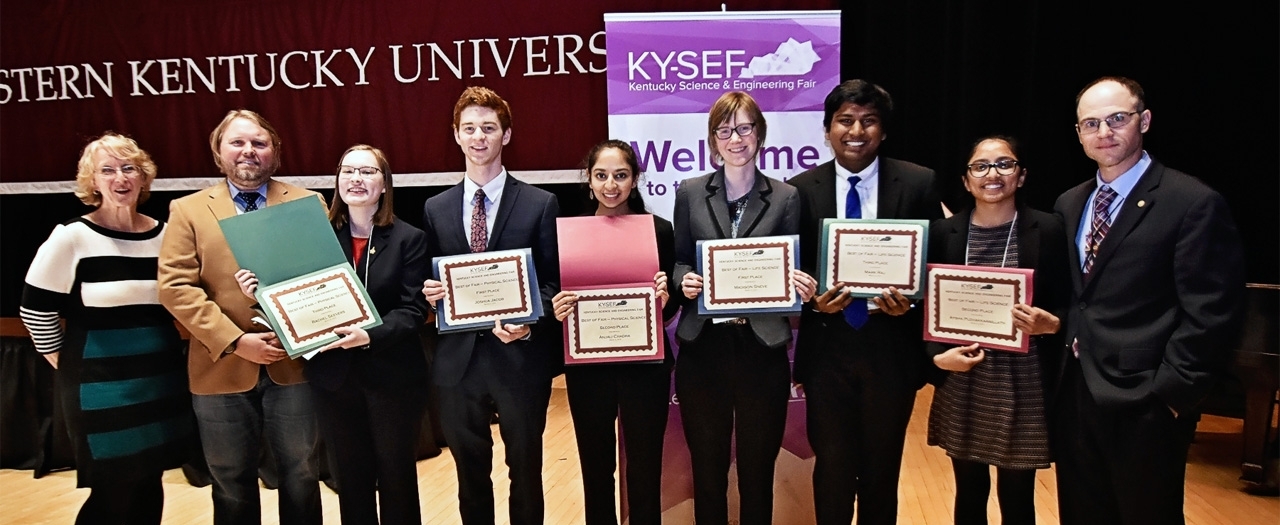
The 16th annual Kentucky Science and Engineering Fair (KY-SEF) was held March 24 at Eastern Kentucky University’s Alumni Coliseum.
Overall, 297 students representing 280 projects were on hand to compete for awards in 22 middle school and 22 high school categories ranging from animal sciences to robotics and intelligent machines. Students in the high school division at the state fair and several other regional fairs also competed for the coveted “Best of Fair” honors, which enable students to compete at the Intel International Science and Engineering Fair (ISEF) in Pittsburgh, Pennsylvania, May 13-18.
The modern Kentucky science fair now boasts a robust array of cutting-edge topics ranging from physics to exploring efficiencies in plane wing structures to molecular biology techniques for exploring the cancer suppression effects of Kentucky’s native fruits. A 2016 state fair winner, Mukund Venkatakrishnan, a Louisville Manual High School student, developed a $60 hearing aid for his 81-year-old grandfather in India.
“These students are not building paper machete model volcanoes. Instead they are at the forefront of a lot of current scientific questions and developing innovative solutions to problems,” said Dr. Robin Cooper, KY-SEF board member and associate professor of biology at the University of Kentucky. “A lot of people, especially our new judges from industry and our universities, are amazed at the caliber of work be presented at our state and regional fairs. Many leave the state fair after fulfilling their volunteer judging duties just blown away.”
The top three high school winners in the life sciences were Madison Sneve (1st place), Aysha Puzhakkaraillath (2nd), and Mark Raj (3rd). Sneve’s project provided evidence that specific neurons (TrkC neurons) are responsible or at least somewhat responsible for taste by the tongue, which may help others study how to treat tongue and taste disorders. Puzhakkaraillath presented evidence that exercise in mice fed a high-fat diet prevented cognitive impairment and promoted healthy gene expression. Raj focused his efforts on supporting the development of an artificial human pancreas to automatically administer insulin to the body when needed in diabetic patients. Using data from 23 virtual patients, Raj developed a proof-of-concept controller using a processing algorithm to predict and learn appropriate insulin dosages for individual patients.
In the high school division for physical sciences, the top three winners were Joshua Jacob (1st), Anjali Chadha (2nd), and Rachel Seevers (3rd). Jacob presented his novel 3-D printer capable of addressing a limitation of existing 3-D printing whereby his printer design allows for the use of inks capable of electrical conduction. Jacob’s design can be used for 3-D printing multi-layer circuits, next-gen solar cells, medical sensors, and more. Like Jacob, Chadha’s project also used 3-D printing, and in her project, she developed a portable 3-D printed sensor for arsenic detection in water. Chadha’s sensor is also IoT-based (internet-of-things) whereby it is capable of taking measurements and storing them in the Cloud. Arsenic is thought to be the top cancer-causing pollutant in water worldwide. Lastly, Seevers presented her research on virtual winglets, whereby her virtual design overcomes several lift-to-drag ratio problems facing current physical winglets used by current commercial, cargo, and military aircraft. Her "Virtual Winglet" design appears to enhance the velocity, maneuverability, fuel efficiency and safety of aircraft.
The awards ceremony featured dynamic remarks from Jason Rainey, deputy executive director of the Kentucky Cabinet for Economic Development’s Office of Entrepreneurship, who spoke about the role of young people in continuing to move Kentucky forward through innovation, ingenuity and passion. Upon announcing all the winning projects at the closing ceremony in Brock Auditorium, Fair Co-Director Dr. Jason Marion, associate professor of environmental health at Eastern, provided remarks to the students and other attendees.
“Science and engineering is a big part of what made America and Kentucky the great nation and state we have today, and like those before you, the world has its problems and you all are capable of solving these problems. I’ve seen it,” Marion said. “When the winners from here today go on to ISEF, they represent Team Kentucky, and they don’t just compete with the best of the best; they beat the best of the best. You are Team Kentucky, so be proud.”
Upon reflection, Rainey advised fair leadership that these young folks are role models that should be celebrated across the Commonwealth. “The traits of professionalism, creativity and passion displayed by these young people are just incredible," Rainey said. "Kentucky’s positive energy around economic development right now is outstanding and it’s moving Kentucky forward at a fast pace, but these kids and this fair are next-level, and their ideas and winning spirit can take Kentucky to the new heights. The entrepreneurial spirit, problem-solving skills, and sheer determination I saw in these middle and high school students gives me great hope for what is possible here in Kentucky. Our people can compete with anyone, anywhere.”
For a full list of category, middle school best-of-fair, and special awards winners, visit kysciencefair.org or contact Jason Marion at jason.marion@eku.edu. The fair is actively seeking a title sponsor. For 2017 the fair received support from the EKU Hummel Planetarium, the Kentucky Science and Engineering Foundation, and major sponsors Lexmark, Battelle and Coca-Cola Bottling Co. Consolidated.